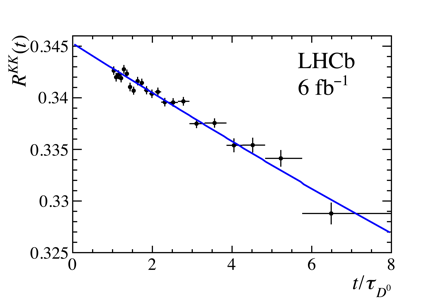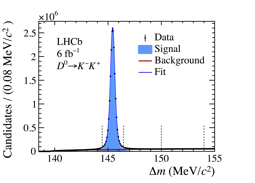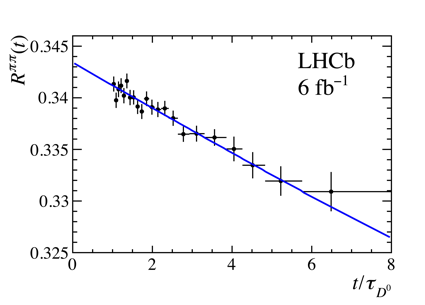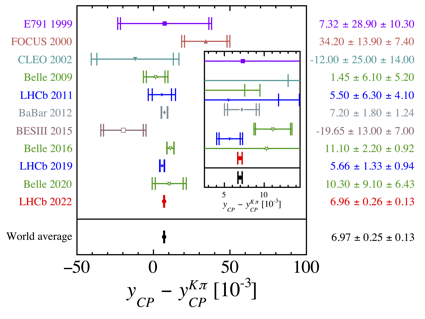yCP – yCPKπ = (6.96±0.26±0.13)x10-3
Today, the LHCb Collaboration submitted for publication a paper that reports the results of the high precision measurement of the charm oscillation (mixing) parameter yCP – yCPKπ using two body D0 meson decays. The result is more precise than the current world average value by a factor of four.
The neutral meson particle-antiparticle systems, Bs0−Bs0, B0–B0, D0–D0 and K0–K0 oscillate (transform into their antiparticle and back) with very different frequencies. The Bs0−Bs0 oscillations are the fastest, about 3 million million times per second (3×1012). The oscillations B0–B0 are about 37 times slower while the oscillations D0–D0 are even slower; the oscillation period is over one hundred times larger than the average lifetime of a D0 meson. Therefore only very few D0 mesons have the time to oscillate before decaying.
The quantum mechanical treatment of neutral charm meson oscillations leads to two neutral mesons, D1 and D2, each with their own mass, m1 and m2, and typical lifetime represented by their decay width, Γ1 and Γ2. The D0-D0 oscillations are described by the two dimensionless parameters, x=(m1-m2)/Γ, determining the frequency of oscillations, and y=(Γ1-Γ2)/Γ, in which Γ is the average width, (Γ1+Γ2)/2.
LHCb physicists studied the D0 meson decays into K–K+, π–π+ and K–π+ meson pairs. The images below show the size and purity of the event sample accumulated around the D0 mass, where almost a hundred million D0 mesons are included.
The y parameter, defined above, is of the order of half a percent. This implies that the experimentally measured lifetimes τ of D0→f decays (f= K+K–, π+π–) differ slightly from the lifetime of D0→K–π+. The lifetime difference is measured via the parameter
yCPf – yCPKπ = (τ(D0→K–π+)/τ(D0→f)) – 1. [for experts: the decay D0→K–π+ is a CP-mixed state with τ(D0→K–π+) ≈ 1/Γ; the decay D0→f is a CP-even state with τ(D0→f) < τ(D0→K–π+)]
In previous publications the measured parameter yCPf – yCPKπ was assumed equivalent to yCP. However, at the precision reached with the full Run2 LHCb data sample, the contribution from yCPKπ, which is about -0.4×10-3, can no longer be neglected.

The parameters yCPf – yCPKπ are measured experimentally from the ratios Rf(t) of the number of D0→f over D0→K–π+ decays as a function of the reconstructed D0 decay time t. The images above show the measured ratios Rππ(t) and RKK(t). The slope of the time distributions, fitted with the exponential function, determines the values of the yCPππ – yCPKπ and yCPKK – yCPKπ parameters. The two measurements are combined to give yCP – yCPKπ = (6.96±0.26±0.13)x10-3. The image below to the left shows a comparison with previous measurements, with the new measurement shown in red. The new LHCb result is compatible with the present world average and is more precise by a factor of four.
This result is combined with previous LHCb charm measurements leading to a new value of the charm oscillation parameter y=(6.46+0.24-0.25)x10-3 with the uncertainty reduced by a factor of more than two as seen in the image above to the right. The precision on y can be further reduced by a simultaneous combination of charm results with measurements of the CKM unitarity triangle angle γ in the beauty particle decays. This will be the subject of a separate publication.
In June 2021 the LHCb Collaboration reported the first observation of a nonzero mass difference between neutral charm mesons, m1-m2≠0. The value represents one of the world’s smallest mass difference between two particles of 6.4×10-6 eV or, when converted to more conventional units, 0.00000000000000000000000000000000000001 grams (1×10-38g). In this way the value of the second charm oscillation parameter, x, was measured extremely precisely. The “b” in LHCb is related to the name of the b quark. Recent results have shown that LHCb is also an LHCc, dominating the world’s best precision in the key parameters of charm physics.
Read more in the LHCb paper. These results have been already presented in CERN seminar, see a direct link to the presentation here.






